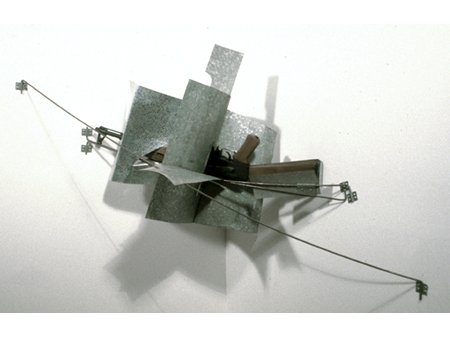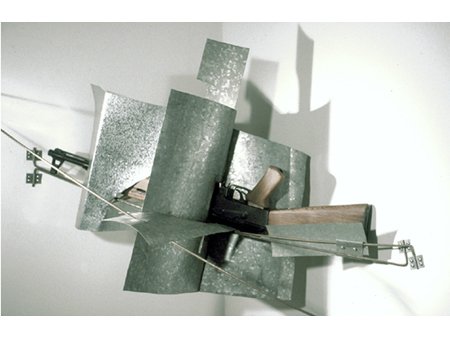Corner Counter-Relief with AK-47 (Utopia-Dystopia)
mixed media
2’ x 5’ x 3’
1989
Vladimer Tatlin’s Corner Counter-Relief of 1917, in terms of artistic development and three-dimensional inventiveness, established at once the progressive vocabulary of abstract formalism, derived from the still-life reliefs of Picasso and Braque he had seen in Paris in 1913. His work’s dynamic entry into lived space, without the anchoring redemption of representation, suggested an emancipatory functionalism wherein abstraction could become the liberating cipher for freedom and progress. Tatlin’s simple hand-made fabrication techniques and common shop materials anticipated the Productivist link between proletarian artists’ work and functional production, along with factura’s program of socially transformative making.


But within thirty years, through the work of the engineer and machinist Mikhail Kalashnikov, the progressive and optimistic impetus of the post-revolutionary soviets’ reflective relation to production had dwindled to an impacted image of destructive mass-produced fabrication: the assault rifle he designed in 1947, the Avtomat Kalashnikov, or AK-47. The abstract linear, planar and schematic example of Tatlin’s singular project now implodes under Stalinist re-organization, as industrial-factory 5-year plans (with their proto-capitalist Fordist and Taylorist methodologies) turn to regulated steel-stamping and forging, and regimented wood pattern-cutting and machine-shaping.
The hand-made transformative experimentalism of Tatlin’s original example transmogrifies into the simple and rugged assembly-line Cold War-era AK-47. This aptly-categorized assault weapon continues in production in several countries worldwide, and is now the most ubiquitous light machine gun on the planet, with well over 100 million produced. It has, through its aggressive functionality, established itself as the universal image of violent transgression and enforced “liberation” throughout the world.
The post-revolutionary experimental period of Soviet art, with its promise of aesthetic social transformation (that now-mythic utopian moment within Western art history) quickly withered, but did not disappear. Within a catastrophic period of thirty years, between 1917 and 1947, there emerged its brutal and distopic inverse; and the instrumental rationality of global production and untrammeled destructive consumption assumed its dismal inheritance.
